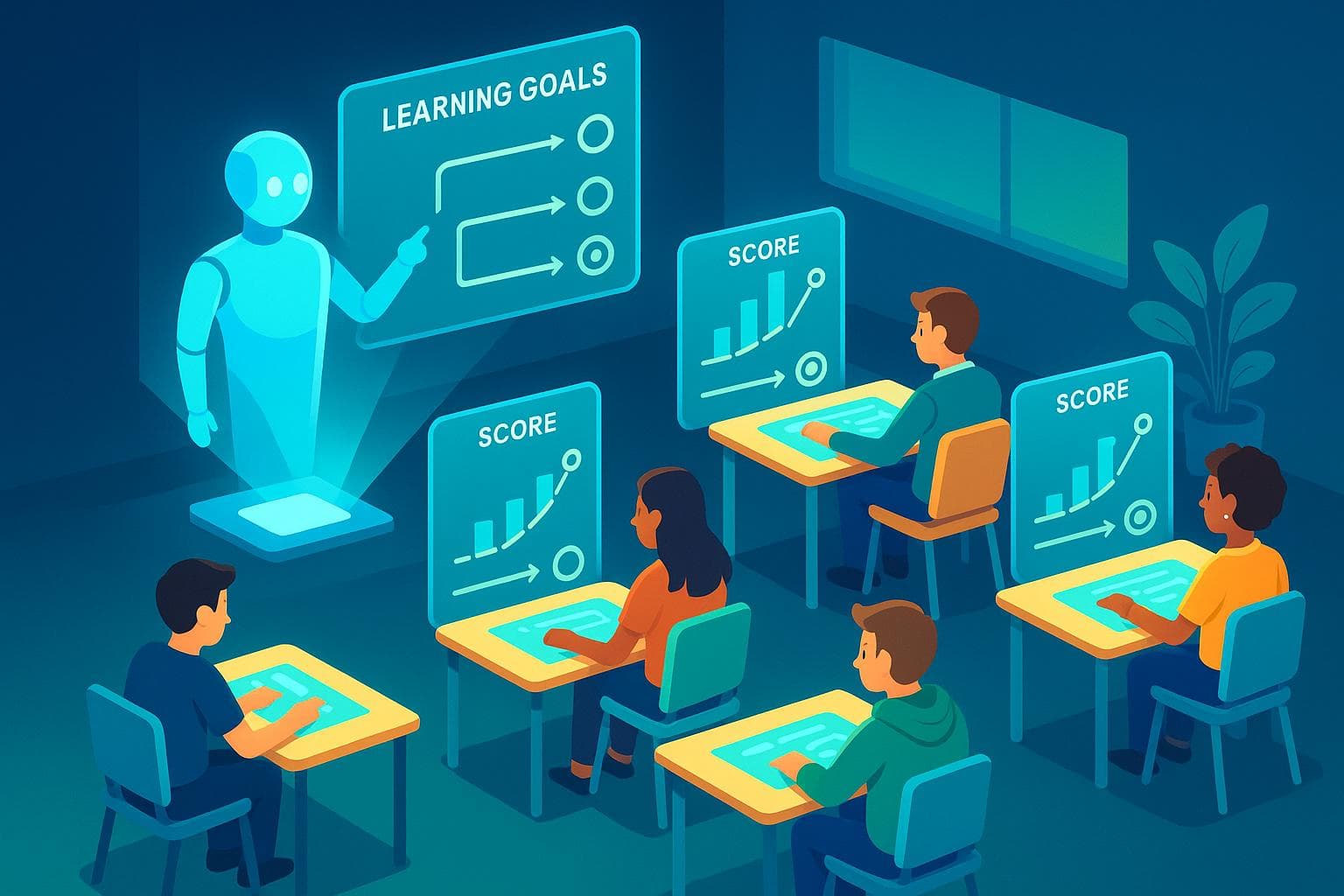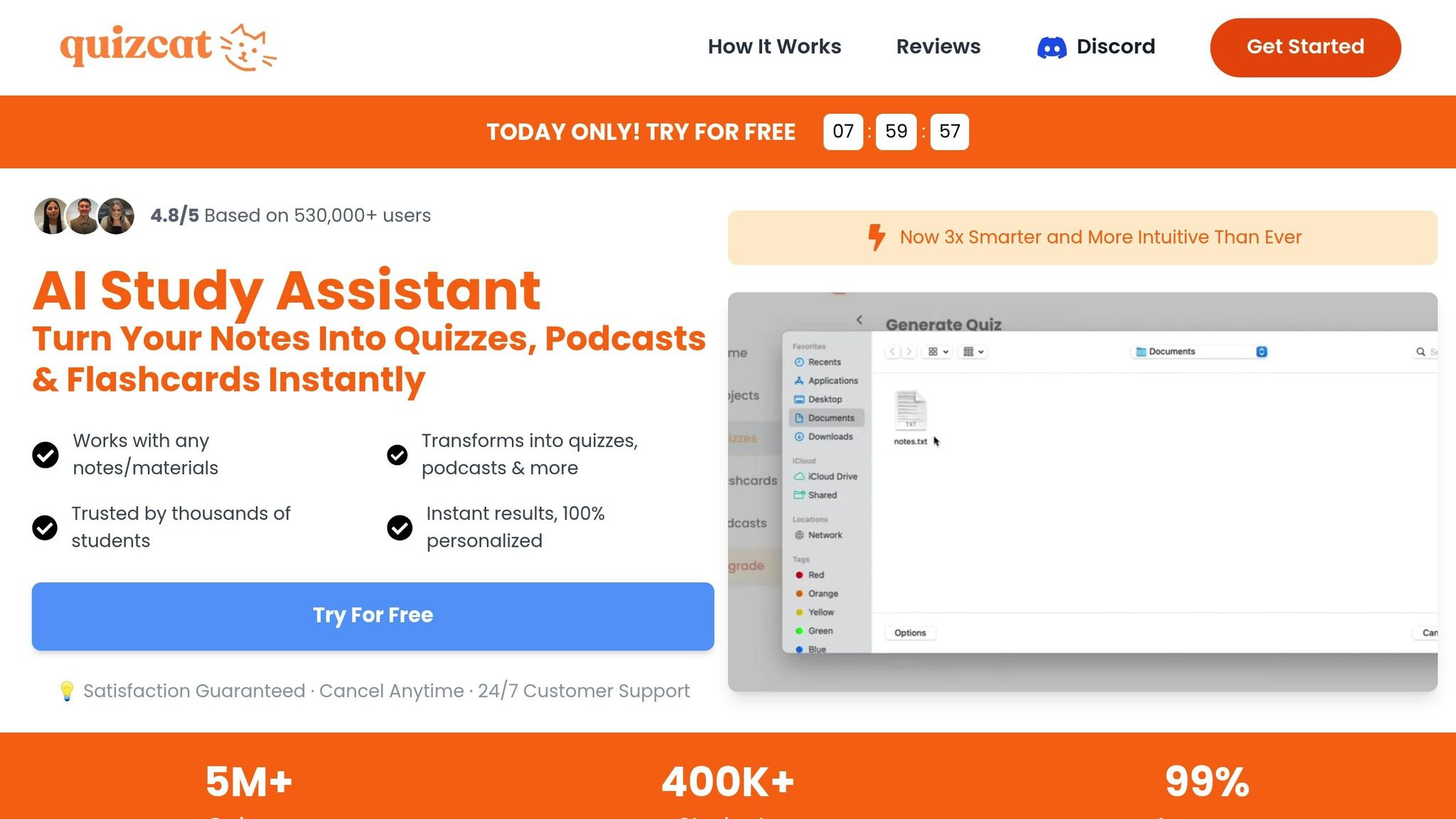
AI Models for Linking Scores to Learning Goals
AI is changing how students and teachers approach learning. By analyzing test scores, AI tools can identify what students have mastered and where they need help. Here's how:
- Personalized Learning: AI connects scores to learning goals, creating tailored study plans.
- Real-Time Feedback: Teachers can adjust lessons based on instant analysis of student performance.
- Targeted Support: AI highlights areas where students struggle and generates specific practice materials.
- Smarter Assessments: Tools like QuizCat AI create quizzes and flashcards based on individual needs.
AI-powered systems make learning more efficient by turning raw scores into actionable insights for both students and educators.
Learning Analytics and Artificial Intelligence in Education - Dr. Yannis Dimitriadis
Score Mapping Process with AI
AI systems play a crucial role in linking student performance to specific learning objectives. This process starts with gathering structured data, followed by selecting the appropriate model and testing its accuracy.
Data Collection Methods
Structured and reliable assessment data forms the foundation of this process. To ensure quality, follow these steps:
- Assessment Structure: Break down learning objectives into measurable elements, such as quiz answers, assignments, or class participation. Clear rubrics are key here.
- Data Standardization: Convert all data into consistent formats to make it suitable for AI processing.
- Quality Assurance: Check for and address any inconsistencies in the data to maintain accuracy.
Choosing the Right AI Model
Selecting the right AI model depends on the nature of your data, the problem's complexity, and the resources available. Here's a quick breakdown:
| Model Type | Best For | Advantages |
|---|---|---|
| Traditional ML | Simple scoring patterns | Easy to implement, straightforward explanations |
| Neural Networks | Complex learning behaviors | Superior pattern recognition, adaptable learning |
| Natural Language Processing (NLP) | Written assessments | Deep analysis of text-based responses |
Testing Model Accuracy
To ensure the AI model performs as expected, rigorous testing is essential:
- Cross-Validation: Test the model across diverse student groups and different types of assessments to ensure reliability.
- Performance Monitoring: Regularly evaluate the model's performance, check for biases, watch for data drift, and have expert educators review the results.
- Continuous Improvement: Refine the model by incorporating new data, educator feedback, and analysis of performance gaps.
"We need the ability to not only have high-performance models but also to understand when we cannot trust those models." - Alexander Amini
AI-Powered Student Feedback
AI technology transforms assessment data into actionable feedback by crafting detailed learning profiles and offering targeted suggestions. This tailored approach supports both educators and students in making smarter decisions about learning strategies.
Custom Study Plans
AI systems dive into performance patterns to create personalized study recommendations that adjust as students progress. These systems take into account various factors:
| Learning Aspect | AI Analysis | Adaptation Method |
|---|---|---|
| Performance Trends | Historical assessment data | Adjusts challenge levels |
| Knowledge Areas | Topic-specific scores | Focuses on weaker areas |
| Learning Pace | Time spent per concept | Tailors content delivery |
| Study Habits | Engagement patterns | Suggests best study times |
Take QuizCat AI as an example - it generates custom flashcards and quizzes based on a student’s assessment results. If a student struggles with certain concepts, the system creates extra practice materials specifically for those topics, ensuring study time is used effectively. Beyond these study plans, AI also hones in on pinpointing learning gaps.
Finding Knowledge Gaps
After creating personalized study plans, AI digs deeper to uncover areas where students are falling behind. These platforms analyze performance data from various learning activities to identify gaps and adjust content difficulty accordingly.
Key elements of AI’s gap analysis include:
- Continuous Assessment: Real-time tracking of student responses to quickly spot struggles.
- Pattern Recognition: Analyzing performance across related topics to reveal underlying weaknesses.
- Targeted Practice Materials: Generating focused review items to address specific problem areas.
sbb-itb-1e479da
QuizCat AI Score Mapping Example

QuizCat AI takes assessment data and turns it into actionable learning materials. This example illustrates how the platform converts scores into tailored study resources to enhance learning outcomes.
Creating Study Materials from Scores
QuizCat AI evaluates student performance using a variety of metrics. Once assessments are completed, the platform analyzes responses based on specific aspects like these:
| Assessment Aspect | AI Analysis Method | Learning Output |
|---|---|---|
| Topic Mastery | Groups performance into clusters | Personalized flashcards |
| Time Management | Tracks response times | Focused quiz sets |
| Error Patterns | Analyzes incorrect answers | Targeted review materials |
| Concept Relations | Links related topics | Connected learning paths |
Using this data, QuizCat AI generates study materials that align with individual learning needs.
"AI has the power to understand learners' assessment results on a broader scale, helping to guide learners on what content they should work with to build these skills based on the individual's learning preference. AI can also provide feedback on key areas for improvement."
Progress-Based Updates
QuizCat AI doesn't stop at creating study materials - it continuously refines its recommendations based on progress:
-
Performance Tracking and Content Adaptation
The system adjusts study content by analyzing assessment data. As students improve, the AI introduces new practice questions and modifies material to match their evolving skill levels. -
Skill Gap Analysis
Regular reassessment helps identify areas that need improvement. By focusing on these gaps, the platform ensures that learning priorities stay aligned with performance data.
With this approach, QuizCat AI fosters an ongoing improvement cycle. Every assessment contributes to more precise study resources, seamlessly linking scores to learning goals.
Conclusion: Next Steps in AI Education
Main Points
AI-powered score mapping is changing the way we approach learning by turning assessment data into clear, actionable goals. This technology pinpoints knowledge gaps with precision, paving the way for personalized learning paths that evolve as students progress. By analyzing performance data in real time, AI uncovers patterns in learning behaviors that traditional methods often miss.
"AI can undoubtedly enhance efficiency and accuracy, yet it lacks the essence of human intelligence and personal interaction." – Stephanie Speicher, Digital Fluency Faculty in Residence, Weber State University
Here’s a breakdown of the key advantages of AI-driven assessment systems:
| Benefit | Impact | Learning Outcome |
|---|---|---|
| Real-time Analysis | Immediate performance tracking | Faster learning adjustments |
| Personalized Feedback | Tailored learning paths | Better knowledge retention |
| Complex Skill Assessment | Evaluation of modern skills | Broader skill development |
| Continuous Adaptation | Dynamic content updates | Enhanced learning efficiency |
These features highlight how AI can be seamlessly integrated into everyday study routines to improve outcomes.
Start Using AI Study Tools
To make the most of AI in your studies, start small and build gradually. Platforms like QuizCat AI simplify this process by turning assessment data into actionable learning resources that are easy to use.
Here’s how to get started:
- Focus on one subject at a time, define specific learning goals, and monitor your progress closely.
- Use the feedback generated by the AI to refine your study methods.
- Regularly assess how well the AI-recommended materials are helping you achieve your goals.
"The key is to start small, with one assignment, one idea, in one course, during one semester."
As AI continues to advance, its ability to evaluate complex skills - like collaboration, creativity, and problem-solving - makes it an indispensable tool for developing the competencies needed in today’s world. Combining AI's precision with expert guidance transforms raw assessment scores into meaningful, actionable goals. QuizCat AI exemplifies this approach, offering a smarter way to study through data-driven insights and tailored learning strategies.
FAQs
How does AI create personalized learning plans based on a student's performance?
AI crafts personalized learning plans by examining a student's performance data to uncover their strengths, areas for improvement, and preferred learning styles. With these insights, it adjusts lessons, selects study materials, and creates customized learning paths to guide students toward their objectives.
Through tools like data analysis and predictive modeling, AI identifies where students may need additional help, recommends specific resources, and delivers real-time feedback. This approach makes learning more effective and engaging by tailoring the experience to each student's unique needs.
What should I consider when selecting an AI model to connect assessment scores with learning goals?
When choosing an AI model to connect assessment scores with learning goals, it's important to weigh a few critical factors:
- Alignment with learning objectives: The model should be capable of accurately linking scores to the specific educational goals you're targeting.
- Data quality: Reliable results depend on high-quality data. Ensure your data is accurate, complete, and relevant to the learning environment.
- Transparency and trust: Opt for a model that provides clear insights into how it works and explains its outputs, fostering confidence among educators and learners.
- Relevance to your needs: Assess whether the model's algorithms and structure are a good fit for your data and the outcomes you aim to achieve.
By keeping these considerations in mind, you can select an AI model that enhances personalized learning and supports better educational results.
How does AI provide accurate and reliable feedback for students and educators?
AI brings a level of precision to feedback that’s hard to match. It analyzes data thoroughly and tailors its insights to each student’s unique learning needs. By pinpointing strengths and areas that need work, it helps students zero in on what truly matters for their growth.
What’s more, AI tools work to reduce bias and offer fairer evaluations by assessing performance objectively. With features like automated grading, real-time analysis, and the ability to process large amounts of data quickly, feedback becomes not only faster but also more reliable. This combination of speed and accuracy supports both educators and students in achieving better results.
